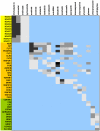A chemocentric approach to the identification of cancer targets
- PMID: 22558171
- PMCID: PMC3338416
- DOI: 10.1371/journal.pone.0035582
A chemocentric approach to the identification of cancer targets
Abstract
A novel chemocentric approach to identifying cancer-relevant targets is introduced. Starting with a large chemical collection, the strategy uses the list of small molecule hits arising from a differential cytotoxicity screening on tumor HCT116 and normal MRC-5 cell lines to identify proteins associated with cancer emerging from a differential virtual target profiling of the most selective compounds detected in both cell lines. It is shown that this smart combination of differential in vitro and in silico screenings (DIVISS) is capable of detecting a list of proteins that are already well accepted cancer drug targets, while complementing it with additional proteins that, targeted selectively or in combination with others, could lead to synergistic benefits for cancer therapeutics. The complete list of 115 proteins identified as being hit uniquely by compounds showing selective antiproliferative effects for tumor cell lines is provided.
Conflict of interest statement
Figures






References
-
- Caldwell JS. Cancer cell-based genomic and small molecule screens. Adv Cancer Res. 2007;96:145–173. - PubMed
-
- Kamb A, Wee S, Lengauer C. Why is cancer drug discovery so difficult? Nat Rev Drug Discov. 2007;6:115–120. - PubMed
-
- Heng HH, Liu G, Stevens JB, Bremer SW, Ye KJ, et al. Genetic and epigenetic heterogeneity in cancer: the ultimate challenge for drug therapy. Curr Drug Targets. 2010;11:1304–1316. - PubMed
-
- Slater K. Cytotoxicity tests for high-throughput drug discovery. Curr Opin Biotechnol. 2001;12:70–74. - PubMed
-
- Weinstein JN, Myers TG, O'Connor PM, Friend SH, Fornace AJ, Jr, et al. An information-intensive approach to the molecular pharmacology of cancer. Science. 1997;275:343–349. - PubMed
Publication types
MeSH terms
Substances
LinkOut - more resources
Full Text Sources

